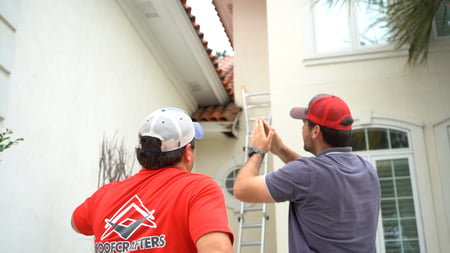What Roofing Work Does Homeowners Insurance Actually Cover?
June , 2025 | 6 min. read

Let’s set the scene: You walk outside one morning, coffee in hand, and look up to admire the sunrise, only to see that your roof has taken a beating. Maybe it’s missing a few shingles, or there’s water dripping from your ceiling. Maybe a tree limb went full WWE and slammed into your attic. You’re now standing there thinking, “Wait… does my homeowners insurance cover this?”
It’s a fair question, and one we here at RoofCrafters get a lot. The truth is, while homeowners insurance can swoop in like a superhero during a roofing emergency, it won’t always foot the bill.
Knowing what’s covered, what’s not, and how to maximize your chances of a successful claim can make all the difference between a frustrating denial and a fully paid roof replacement. So, let’s break it down together, shall we?
Roof Damage is Inevitable, but Insurance Confusion is Optional

Roofs endure everything from blazing sun to hurricane-force winds, often without complaint. But when damage does happen, homeowners like you and I are often caught off guard by what our insurance policy actually includes.
Some people assume insurance covers any roof work. Others fear it covers nothing. The reality? It’s somewhere in between, and it’s all about the cause of the damage, not just the damage itself. If you don’t understand what your policy includes, you could be left paying thousands out of pocket or missing out on coverage you were actually entitled to.
What’s Typically Covered by Homeowners Insurance?

Homeowners insurance is designed to protect against sudden, accidental events, not everyday wear and tear. Most standard policies include dwelling coverage, which covers your roof as part of the structure of your home.
But the key word here is “peril.” If your roof is damaged by a covered peril, insurance will typically pay for repairs or replacement, minus your deductible. Common covered perils include:
- Windstorms and hail: If a strong storm tears off shingles or hail punches dents in your metal roof, your insurer is likely to approve your claim.
- Falling objects: If a tree crashes into your home or branches damage your roof during a storm, you’re usually covered.
- Fire and smoke: Fires are a no-brainer. Homeowners insurance nearly always covers roof damage from flames or smoke.
- Vandalism or theft: If someone damages your roof intentionally (as awful as that sounds), your policy probably has you covered.
- Weight of snow or ice: In colder climates, snow and ice buildup can cause roof collapse, which is another covered peril.
What’s Not Usually Covered?
Unfortunately, insurance companies don’t pay for roofing issues that stem from poor maintenance or natural aging. Here are the main exclusions:
- Wear and tear: If your roof is 25 years old and leaking, that’s on you, not your insurer.
- Neglect or improper maintenance: Ignoring mold, failing to clean gutters, or putting off known repairs can lead to denied claims.
- Pest damage: Squirrels, raccoons, or termites turning your attic into their bed and breakfast? Insurance rarely covers it.
- Installation errors: If your roof was installed incorrectly, insurance typically won’t pay for the resulting damage.
How to Maximize Coverage and Minimize Denials

Understanding what’s covered is just step one. If you want to get the most out of your homeowners insurance, follow these strategies:
Read Your Policy (Yes, Really)
It’s tempting to toss your policy in a drawer and forget it exists, but a little reading can go a long way. Look for the “dwelling coverage” section and pay attention to any exclusions or endorsements related to roofing. If something’s unclear, don’t hesitate to call your insurance agent and ask questions.
Document Everything
If your roof is damaged, take photos immediately, preferably with timestamps. Capture close-ups of the damage and wide shots of the entire roof. If you noticed a specific event (like hail or wind), make a note of the date and time. This documentation can be the difference between a smooth approval and a frustrating denial.
Act Fast
Most insurance companies have a time limit for reporting roof damage, sometimes as short as 30 days. The longer you wait, the harder it is to prove the damage was sudden or related to a covered peril.
Get a Professional Inspection
Bringing in a trusted, licensed roofing contractor (like us!) to assess the damage before you file a claim can strengthen your case. A detailed inspection report from a professional carries more weight with insurance adjusters than photos alone.
Keep Maintenance Records
Insurance companies love homeowners who take care of their property. Keep a log of your roof’s maintenance, cleaning gutters, replacing flashing, inspecting after storms, etc. It helps prove you’ve been proactive, not negligent.
Don’t Jump to Replace Before You File
We get it, leaks are stressful. But don’t rush into a full roof replacement before contacting your insurance company. They need to assess the damage themselves before you make major changes. Otherwise, you could void your claim.
Bonus: What About Partial Coverage?
Here’s a curveball: sometimes insurance will approve partial repairs, but not a full roof replacement. For example, if only one section of your roof was damaged in a storm, they might pay to fix that section alone.
However, in some cases, the materials on your roof may no longer be available. If that’s the case, and your contractor can’t find a perfect match, some insurance policies will cover the cost of replacing the entire roof to maintain visual uniformity. That’s known as matching coverage, and it’s worth checking if your policy includes it.
Know Your Deductible (and If You Have a Hurricane Clause)
Especially in hurricane-prone states like Florida, Georgia, and South Carolina, many policies have separate deductibles for hurricane damage, often a percentage of your home’s value rather than a fixed amount.
So, while your regular deductible might be $1,000, your hurricane deductible could be $5,000 or more. It’s crucial to understand what those numbers are before you’re dealing with a storm claim.
Your Roof Deserves (and Needs) Insurance Smarts
At the end of the day, your roof shouldn’t be an afterthought, and your homeowners insurance is your financial safety net when disaster strikes. But the gap between what you think is covered and what actually is covered can be a rude awakening.
Don’t let insurance confusion leave you out in the rain. Take a little time to understand your policy, take good care of your roof, and always call in a roofing pro if you’re unsure about the damage or next steps. And if you’re looking for a team that knows the ins and outs of roofing and how to help you navigate the insurance process, we’ve got you covered, literally.
Need help with a roof inspection after a storm or suspect damage from a covered peril? Contact RoofCrafters today for a professional, time-stamped inspection and expert guidance on your insurance claim. We’re here to protect your home from the top down!
My name is Cassie, and I’m the Content Manager here at RoofCrafters. I was born and raised in Chicago, Illinois, and made my way out to Florida post-college graduation. I’m incredibly passionate about writing and creating valuable content that helps others with the collaboration of my marketing team. When I’m not working, I enjoy shopping (a little too much), spending time at the beach, and reading!




